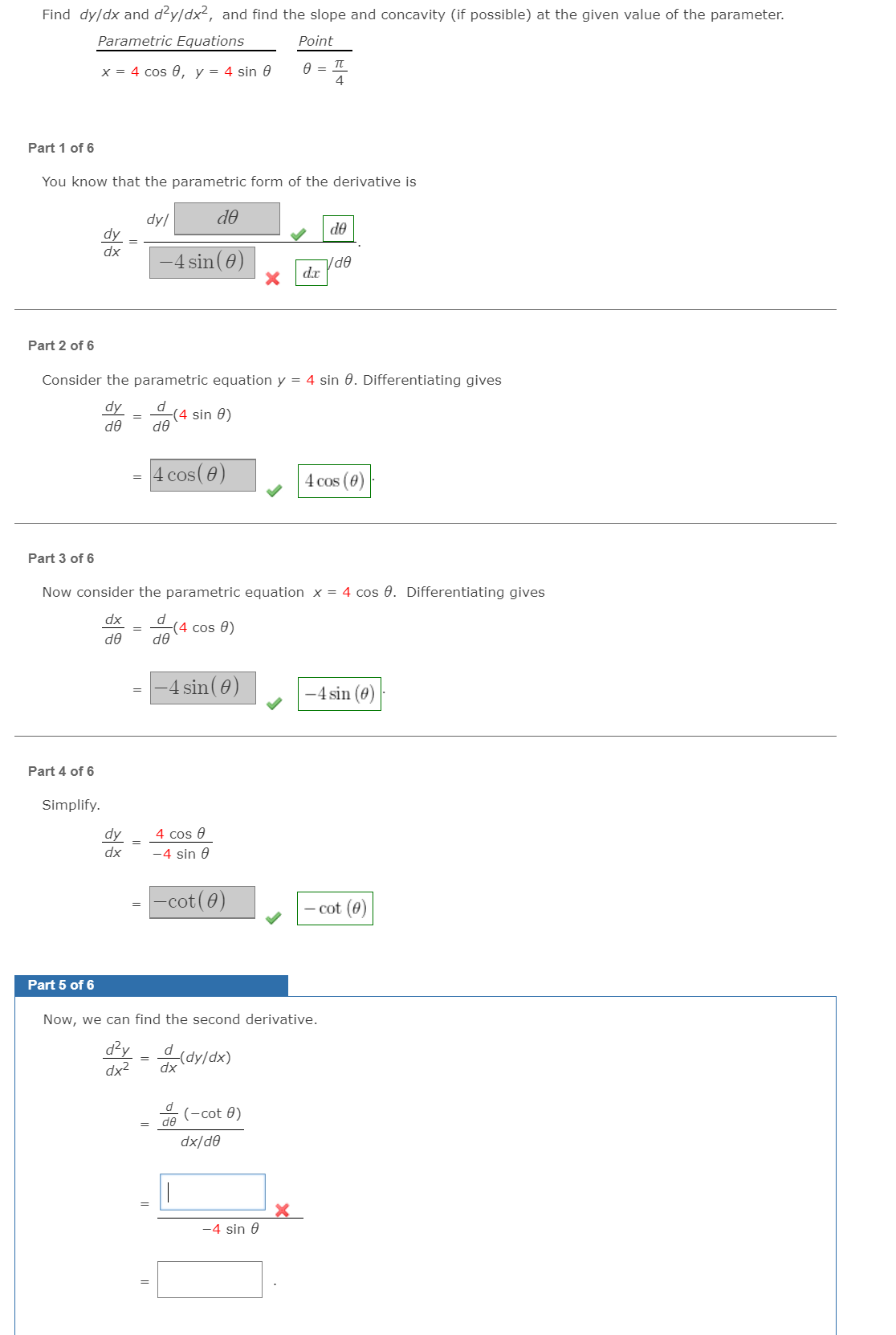Find dy/dx and d?y/dx², and find the slope and concavity (if possible) at the given value of the para Parametric Equations Point x = 4 cos 0, y = 4 sin 0 4 Part 1 of 6 You know that the parametric form of the derivative is dy/ do de dy dx = -4 sin (0) dx Part 2 of 6 Consider the parametric equation y = 4 sin 0. Differentiating gives dy de d (4 sin 0) de 3D 4 cos(0) 4 cos (0) Part 3 of 6 Now consider the parametric equation x = 4 cos 0. Differentiating gives dx d (4 cos 0) de de -4 sin(0) -4 sin (0) Part 4 of 6 Simplify. 4 cos 0 -4 sin 0 dy dx -cot(0) - cot (0 Part 5 of 6 Now, we can find the second derivative. (dy/dx) dx2 (-cot 0) de OP/xp
Find dy/dx and d?y/dx², and find the slope and concavity (if possible) at the given value of the para Parametric Equations Point x = 4 cos 0, y = 4 sin 0 4 Part 1 of 6 You know that the parametric form of the derivative is dy/ do de dy dx = -4 sin (0) dx Part 2 of 6 Consider the parametric equation y = 4 sin 0. Differentiating gives dy de d (4 sin 0) de 3D 4 cos(0) 4 cos (0) Part 3 of 6 Now consider the parametric equation x = 4 cos 0. Differentiating gives dx d (4 cos 0) de de -4 sin(0) -4 sin (0) Part 4 of 6 Simplify. 4 cos 0 -4 sin 0 dy dx -cot(0) - cot (0 Part 5 of 6 Now, we can find the second derivative. (dy/dx) dx2 (-cot 0) de OP/xp
Algebra & Trigonometry with Analytic Geometry
13th Edition
ISBN:9781133382119
Author:Swokowski
Publisher:Swokowski
Chapter11: Topics From Analytic Geometry
Section11.4: Plane Curves And Parametric Equations
Problem 62E
Related questions
Question

Transcribed Image Text:Find dy/dx and d?y/dx², and find the slope and concavity (if possible) at the given value of the parameter.
Parametric Equations
Point
x = 4 cos 0, y = 4 sin 0
4
Part 1 of 6
You know that the parametric form of the derivative is
dy/
do
de
dy
dx
=
-4 sin (0)
dx
Part 2 of 6
Consider the parametric equation y = 4 sin 0. Differentiating gives
dy
de
d
(4 sin 0)
de
3D
4 cos(0)
4 cos (0)
Part 3 of 6
Now consider the parametric equation x = 4 cos 0. Differentiating gives
dx
d
(4 cos 0)
de
de
-4 sin(0)
-4 sin (0)
Part 4 of 6
Simplify.
4 cos 0
-4 sin 0
dy
dx
-cot(0)
- cot (0
Part 5 of 6
Now, we can find the second derivative.
d?y
dx2
dy/dx)
(-cot 0)
OP/xp
-4 sin 0
Expert Solution
This question has been solved!
Explore an expertly crafted, step-by-step solution for a thorough understanding of key concepts.
Step by step
Solved in 3 steps with 3 images

Recommended textbooks for you

Algebra & Trigonometry with Analytic Geometry
Algebra
ISBN:
9781133382119
Author:
Swokowski
Publisher:
Cengage

Algebra & Trigonometry with Analytic Geometry
Algebra
ISBN:
9781133382119
Author:
Swokowski
Publisher:
Cengage